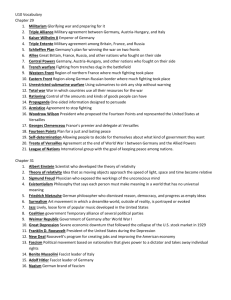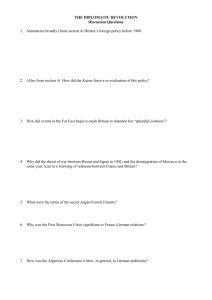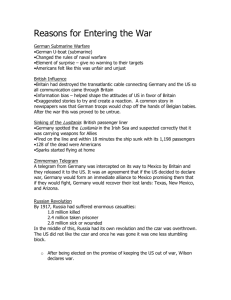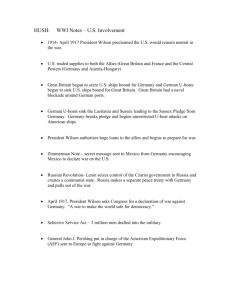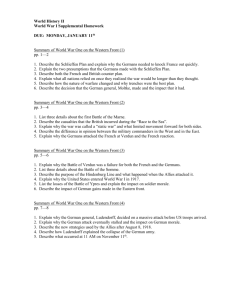World War 2 PowerPoint
advertisement
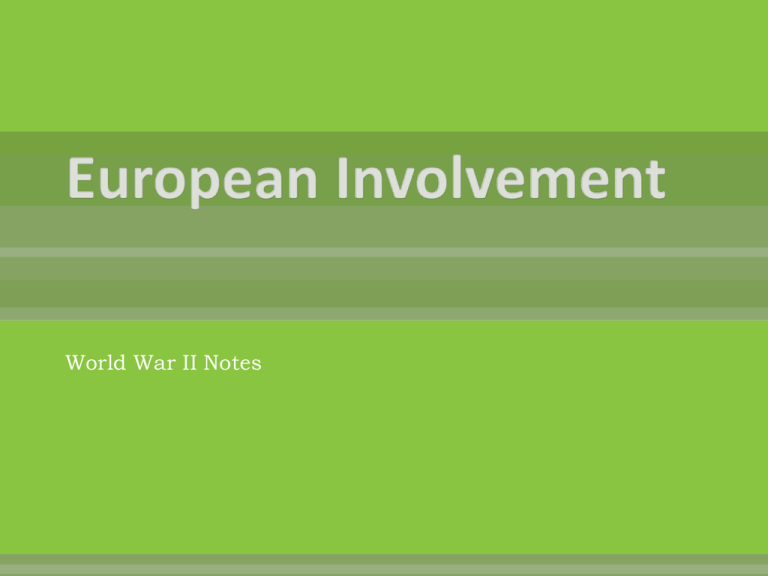
World War II Notes Terms that you should know Militarism Nationalism Imperialism France Germany Great Britain Italy United States Japan Russia New forms of governments formed after World War 1 Totalitarian rule-Idea that a government exerts total control over a nation. Fascism- Emphasizes the importance of the nation or an ethnic group and the supreme authority of the ruler. (ITALY) Nazism-The belief in Germany of the superiority of an ethnic group or race Socialism- where everyone is created equal and the nation is to provide for everything for everybody. New forms of governments formed after World War 1 Communism- A system of government in which a nation is created where it has no individual states, money is not important and that a class system doesn’t exist. (Russia and today China) Leader-Stalin Comes to power in 1924 after Lenin’s Death and has his own idea’s of Communism Stalin’s Economic plans for Russia Agriculture Combined family farms into huge collectives run by the state. (Cooperatives) This led to terrible shortages of food and Stalin punished his own people who resisted the changes. (Either killed them or sent them to prison camps in Siberia.) pg 569 Industry Took his people and assigned them to build industrial centers to produce coal, iron, oil etc. Guns versus butter-Stalin put all of the Soviet Unions wealth and money into industry, there was a shortage of housing, clothing and food. How did Stalin accomplish all of this in 10 years??? Purges-removing enemies and undesirable people from power Reign of Terror-Stalin removed anyone who could threaten his power in the Communist party by trials By 19397 million arrested, 1 million executed and millions more in forced labor camps. Fascism Leader- Benito Mussolini Fought in world war 1, angry over the agreements of the Versailles Treaty, started to speak up against the government Formed the Fascist party and started to take control by using gangs to gain power. Named Prime Minister when Mussolini threated to march on Rome, Italy. Fascism Leader- Benito Mussolini To end Italy's economic problems they outlawed Elections Other political parties Established a dictatorship with him in control. Nazism Leader-Adolf Hitler Wounded in World War 1 also. Had a profound hatred of the war-guilt cause, which blamed Germany for the war. Formed the Nazi party in response to what was happening in Germany at this time (Unemployment, Inflation, Starvation, etc.) Great Public Speaker and attracted many followers after the war. The Nazi Party November 1923-Hitler tried to overthrow the German government and was sentenced to prison for 5 years (9 months served) Mein Kampf “My Struggle” proposed anger over the Treaty of Versailles Build up of Germany’s military-Militarism Expanding Germany’s borders-Imperialism Purifying the Aryan (German) race by removing those who were considered undesirable. Prelude to war part 1 Prelude to war part 2 Prelude to war part 3 Wanted to avoid a long war Germany's strategy was to defeat its opponents in a series of short campaigns Strategy: "Blitzkrieg" (lightning war) Tactic based on speed surprise, coordination and movement. Designed to hit hard and then move on instantly Video Required the application of offensive weapons Tanks, planes, and artillery (foot soldiers) Causes shock and disorganization among the enemy defenses German air power prevented the enemy from adequately resupplying or redeploying forces and thereby from sending reinforcements to seal breaches in the front. German forces could in turn surround opposing troops and force surrender. Hitler Unleashes Blitzkrieg German’s invaded Poland September 1st 1939 Denmark and Norway-April 9th 1940 Defeated after 5 days Belgium Defeated in 3 weeks Ultimately FranceJune 10th France Surrendered Most of Europe was under German Control with only Great Britain left to defend itself. Defense and evacuation of British and allied forces in Europe from 26 May–4 June 1940s Part of the Battle of France Operation Dynamo 850 “Little Ships” 2,000 troops per hour Nine days later, 338,226 trapped people were rescued DURKIRK SPIRIT MIRACLE OF DELIVERANCE We saw these small specks popping about all over the place, only when they got real close did we then realize that they were small boats, small boats in their hundreds going the other way. Then we saw that all these craft were manned by civilians, some even wearing trilby hats and smart jackets. They waved to us as they passed and anyone would think that they were on a Sunday cruise down to Windsor, these fellows had no idea as to what was at the end of their journey. A couple of fellows by the handrail gave them a cheer, and suddenly just about every soldier on our ship then gave three hearty cheers lifting their hats at the same time. Wanted space for the “superior race” – Nazi Nationalists The “inferior race” living on Nazi territory – Gypsies and the Jews Sent to concentration camps or ghettos for slave labor or to be sent to death – RESETTLEMENT The Nazis stripped away the Jews lives and their identities in an effort to expand their own race at the expense and mistreatment of the Jewish race. Immediately after the defeat of France, Adolf Hitler ordered his generals to organize the invasion of Britain. Objective was to land 160,000 German soldiers along a forty-mile coastal stretch of south-east England. video Luftwaffe: Germany’s large number of fighter planes Royal Air Force (RAF): Britain's fighter planes German fighters could only stay over England for about half an hour before flying back to their home bases. Britain had a radar system 12th August, 1940, the German air force On the began its mass bomber attacks on British radar stations, aircraft factories and fighter airfields The climax of the Battle of Britain came on the 30th-31st August British lost 50 aircraft compared to the Germany's 41. The RAF were close to defeat but Adolf Hitler then changed his tactics and ordered the Luftwaffe to switch its attack from British airfields, factories and docks to civilian targets. This decision was the result of a bombing attack on Berlin Damage in London London was bombed by the Germans = The Blitz During the conflict the Royal Air Force lost 792 planes and the Luftwaffe 1,389. There were 2,353 men from Great Britain and 574 from overseas who were members of the air crews that took part in the Battle of Britain. An estimated 544 were killed and a further 791 lost their lives in the course of their duties before the war came to an end. Put your feet in the life of a European teen your age during this time period. You can choose to write about being in the shoes of a soldier during a battle, a civilian caught in a battle, or a prisoner in a concentration camp. I expect you to sincerely reflect with the knowledge you learned about the Nazi’s tactics and the morale the underdogs held. Highlight tactics, concepts, and battles we discussed in class. 1-2 paragraphs No grammar/spelling errors. Due in the beginning of class tomorrow. – 10 points… 2 minutes of writing time. Japan as a modern power Fought wars versus china (1894) and Russia (1904) (Defeated them both) Early 1920s, A series of Recessions in the Japanese Economy Went into a depression as a result of the Great Depression in the United States Nationalism Manchurian Incident – Start of Japanese involvement in the pacific Japan Needed resources to feed its people and to power its industry. Feb 1932 Pg 583 Japan’s imperialism Military slowly took control by a series of assassinations after the Manchurian incident China Sino-Japanese war Japan invades China in 1937 Video Burma Road Britain's attempt to help the Chinese by sending supplies down a highway that linked Myanmar to China By annexing the neighboring countries and a build up of its’ military forces, Japan became a world power at this time Neutrality acts1935-Banned U.S. for selling weapons to nations at war 1936-Banned loans to nations at war 1937-Permitted trade in non-military goods as long as they paid cash and transported the goods themselves (CASH AND CARRY) ALL EXAMPLES OF ISOLATIONISM Fireside chats America’s Role in World Politics FDR wanted to be more involved but the Great Depression keep Roosevelt focused on Domestic matters. America’s economy was recovering slowly America’s opinions were to support Britain and go against Germany and Italy (Axis Powers) America’s Role in World Politics Exchange of old Navy Destroyers for military bases in the Western Hemisphere Thought that the exchange would lead the United States into war America First Committee-Group that wanted to prevent further aid to Britain, saying that any more involvement would plunge the nation into war. Lend Lease-Lending Britain money and supplies instead of charging them cash. Pearl Harbor Dec 7th 1941 Japan attacks the United States VIDEO VIDEO 2 President’s speech America prepares for war Fireside Chat America out of the great depression creates industries geared to production of war products (Guns, ammo, ships, etc) GUNS VS. BUTTER The American public goes through a series of steps for rationing products Rationing-limiting the supply of goods sent to the people of a country during a time of crisis. Steps to rationing Office of War Mobilization- VIDEO Victory gardenBlack MarketRation CardRation Stamps- Victory garden- Ration Card- Ration Stamps- Black Market- With the United States now into the war, the Allies and the Axis Powers are now defined as enemies. The United States focuses all its might and energy into helping Great Britain defeat Nazi Germany and help in Europe. Atlantic Charter Video The first action for the allies was in North Africa to gain a toehold into Europe Wolf Packs- German Submarines who wreaked havoc on shipping in the North Atlantic,. They tried to cut off all supplies to the British Island which almost singlehandedly won the war for Germany Video The Eastern Front-Germany invades Russia during June 1941 Germany is halted by the brutal Russian winter at Stalingrad 1942 Eventually they are beaten back after heavy losses of both men and machine. Video Carpet bombing- The use of heavy bombers to reduce a city to rubble to force a country into submission Video The bombing campaign while effective was not a solution to make Germany surrender so an invasion of the European continent was planned D-Day-Operation Overlord The 5 beaches at Normandy France Sword, Omaha, Juno, Utah and gold Saving Private Ryan Lead by Dwight D. Eisenhower, would later become president Largest Amphibious operation of its kind to retake Europe Battle of the Bulge Last German offensive of the war, tried to create a gap in the Allied lines to force a retreat to drag out the war. Video After the German defeat at the battle of the bulge, The allies quickly pull into Germany and defeat is final on May 8th 1945 V-E Day; Victory in Europe Yalta conference: The allies met to divide Germany into four zones and what to do in Europe afterwards Japanese forces advance in the pacific war Fall of the Philippines Bataan Death march U.S. Forces were captured and forced to march to a prisoner camp over the span of 12 days 10,000 died on the march and 15,000 more die at the prison. Geneva Convention Written in 1929 which defined treatment of prisoners of war which the Japanese ignored The war at sea Important battles Battle of the Coral Sea-no one won the battle but prevented the Japanese from invading Australia Battle of Midway-Turning point of the war in the pacific, the U.S. Navy destroyed most of the Japanese carrier fleet VIDEO The victory enabled the U.S. to go on the offensive The war at sea Important battles Battle of Guadalcanal-FEB 1943 1st victory of the U.S. on land which took territory away from Japan Island Hopping-selectively attacking certain islands held by Japan while bypassing others to cut off supplies and reinforcements, enabled the U.S. to get to the ultimate goal, Japan, faster. Map of island hopping Battle of the Leyte Gulf Taking back the Philippines Douglas MacArthur makes good on his promise to return Kamikaze Japan, short on planes and warships, loaded their airplanes with gas and explosives and they crashed into American ships Similar to suicide bombers of today Douglas MacArthur Iwo Jima and Okinawa Most brutal fighting of the Pacific war, these two islands were to provide an air base to attack Japan directly Iwo Jima 25,000 American casualties Okinawa 50,000 died VIDEO VIDEO flag rising Iwo Jima famous photograph Okinawa and Iwo Jima Okinawa and Iwo Jima Japan is ready to be beaten but surrender is not an option in their culture President Roosevelt dies in office April 12th 1945 a month before V-E day Harry S. Truman inherits the office of the presidency and faces a difficult decision in the Pacific war. Get into groups of 2 You are the president of the united states and these are the four scenario’s that you must choose from to end the war in the pacific What would you do as the new president? 1) Invade the main island of Japan and lose 1,000,000 American troops? 2) use a new secret weapon being developed in the United States unleashing a horrible new destructive technology but it is unknown how powerful it is or the long term effects. 3) blockade the island and starve Japan along with bombing them into submission 4) soften demands for an unconditional surrender You must choose from one of the four scenarios and give reasons why your group chose the one you went with, and also give at least 1 reason of why the other reasons were rejected. You have 10 minutes to complete this project and be ready to defend your decision in front of the class Manhattan project To build the world’s first nuclear device Tested at Los Alamos, New Mexico Albert Einstein, a former German scientist worked on the project Created under the direction of Robert Oppenheimer, who after witnessing the successful test (called the Trinity Test) was quoted “Now I am become Death, the destroyer of worlds.” VIDEO V-J Day August 15th 1945 Unconditional surrender aboard the USS Missouri Timeline Anti-Semitism-discrimination or hostility directed at the Jewish population Mid 1800s in Germany Holocaust-term used to describe the persecution and extermination of the Jewish people in Europe by Germany 19331945 Concentration Camp-prison which contained anyone deemed “undesirable” by the German state Kristallnacht-Night of Broken Glass, Nazis destroyed Jewish stores and places of worship and shipped thousands of Jews to the concentration camps after one night November 9th, 1938 Timeline Warsaw Ghetto-1940 Germany houses the Jewish population in the city to starve Wannsee Conference-Nazi officials met and decided on a “Final Solution” of the Jewish question Jan 1942 Which meant the systematic extermination of all Jews in Europe Timeline Genocide-deliberate destruction of an ethnic or cultural group Death Camps-camps designed with one purpose in mind, to kill as many people as possible in the shortest amount of time. Nuremberg Trials-Nuremberg Germany where high ranking German officials were put on trial for crimes against humanity. VIDEO In the end over 6 million Jews were exterminated during World War 2 Holocaust MuseumAuschwitz Concentration Camp Internment-Forced relocation of Japanese citizens in the Western United States to different locations throughout the U.S. Nisei-Term used for Japanese Americans VIDEO The Japanese Americans were forced to leave their homes, businesses, which were then taken by the United States government In 1988, Congress authorized repayment of $20,000 dollars and an apology for the crimes committed by the U.S. government against its’ own citizens
